SUVs are big on versatility but what if your big thing is value? The SUV scene is groaning with choice and if you’re the type who is thinking “What’s the ‘most truck’ I can get for my money?” this comparo is for you. We’ve featured many of the sector players before, but here are a few we haven’t evaluated much over the past few years; the Isuzu MU-X, Hyundai’s Santa Fe and the SsangYong Rexton W. There is a liberal spread of price points here ranging from $50k up to $80k but the trio represents the vastly varied nature of the SUV sector. And at the end of the day, they are all diesel 4x4s with seven seats.
The Santa Fe is often touted as NZ’s most popular SUV and Hyundai was once a value-led brand, but is that still the case? The Isuzu MU-X is a model we haven’t looked at previously and it brings plenty of rugged kudos and capability with it. And then there’s the SsangYong Rexton with which we were reacquainted last month and it sparked the idea of what represents the best buying in the SUV class. So, which of the these three delivers the most versatile value then?
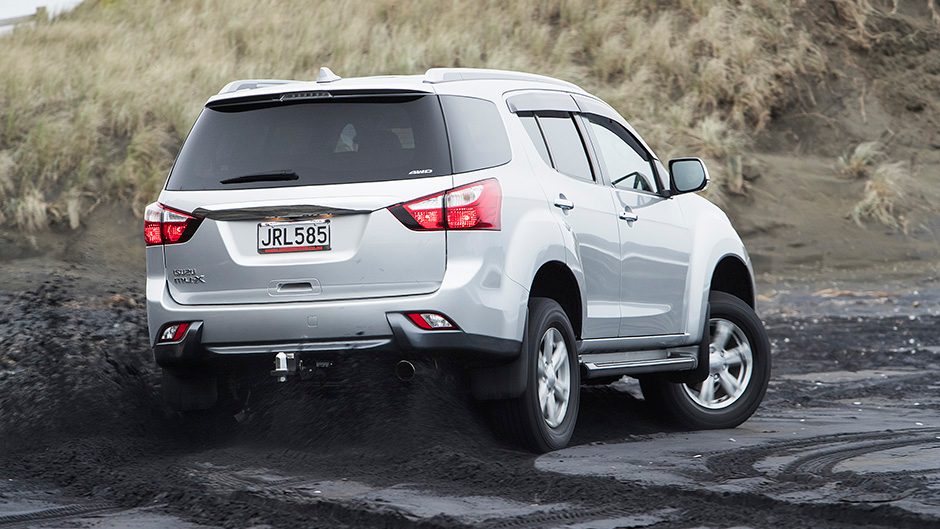
The nitty gritty
The $65,990 Isuzu and $49,990 SsangYong follow the traditional full chassis SUV design ethos with a coil sprung solid rear axle and a part-time 4WD system which is switchable on the fly. And for heavy duty workouts, both have a low-range. The Santa Fe, tested here in top $82k Elite Limited guise, is of the crossover breed, a unibody design with an independant rear. The electronic traction control gizmos are in charge of the on-demand all-wheel drive system and they send drive to the rear wheels when maximum traction is required.
Diesel engines simply make more sense in bigger rigs, and all three have a four-pot solution. The Isuzu has the biggest engine but the least power and torque with 130kW, and 380Nm of twist coming on from 1800rpm from its 3.0-litre. It’s the noisiest of the trio and that the MU-X is also the heaviest here gives it the least favourable power-to-weight ratio. Adding to the dilemma, it has a five-speed auto which affects consumption. Overall the MU-X is rated at 8.4L/100km and it only meets the minimum Euro4 emissions requirement. Once up past 1500rpm, it pulls well but doesn’t rev as freely as the others, and is done by 4000rpm. The auto is a relaxed operator and doesn’t lock-up when you get off the gas either (unless you’re in the manual mode) with the revs dying away on a trailing throttle and so it takes that bit longer to get back on the job when you squeeze the throttle again.
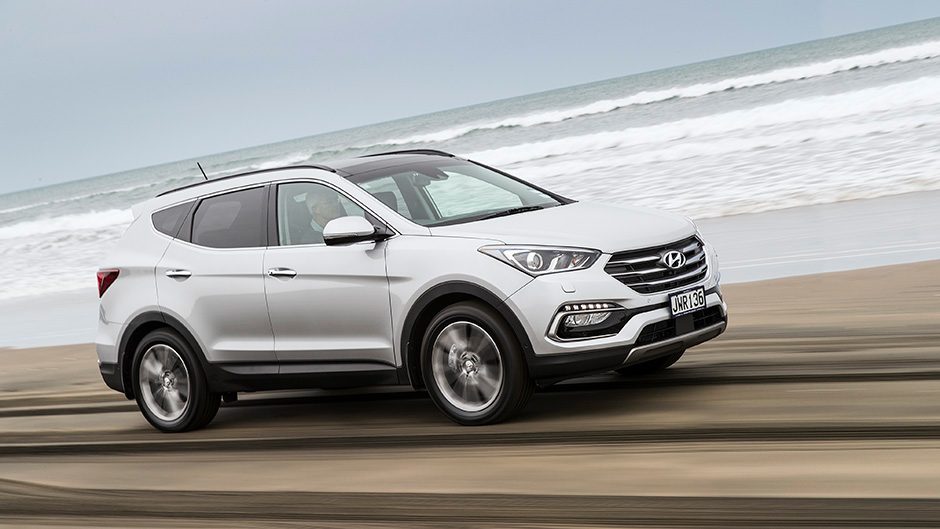
The 2.2-litre unit in Rexton is noticeably smoother and more hushed yet manages to push out similar power and added torque from a smaller capacity. With seven gears courtesy of its Merc-sourced auto, it’s quicker to 100 and easier on fuel as well. In fact, its 7.4L/100km overall average is even better than that of the Santa Fe, and it’s said to meet the more stringent Euro6 regulations. The 2.2 unit in the Hyundai is more powerful again with 147kW and 440Nm. It’s mated to a six-speed auto, and adds various drive modes from Eco to Sport. Like the SsangYong four pot, it’s a quick revver with a good response and minimal lag, though overall is rated at 7.7L/100km while conforming to Euro5 regulations. The SsangYong’s seven-speed box is programmed for smooth shifts and can be a tad hesitant to kick down but give the throttle pedal a good seeing to and it will oblige. The Hyundai’s six-speed auto, once in Sport mode, is quick to respond and, along with the most favourable power-to-weight ratio, helps make the Santa Fe the quickest here.
On the move
The Rexton has a firmer ride than the MU-X, but there’s more roll and dive associated with the softer-riding Isuzu, and its steering is slower. It’s also the first to elicit a squeal from the tyres in bends, the front end pushing wide without a great deal of provocation. The Rexton steers better and holds on longer in the curves though the Hyundai, lower and lighter, is more refined on road than the two bigger rigs. Its on-demand AWD system helps it scurry out of corners well and its steering is more responsive and feelsome in this grouping but is by no means the best in class either. Being lighter always helps and it’s more wieldy in bends. But when cruising along the beach for our photos, its traction control system was having a fit in the softer sand, almost grinding progress to a halt before we disabled it while the lower-riding suspension transmitted more of the bumps along the way.
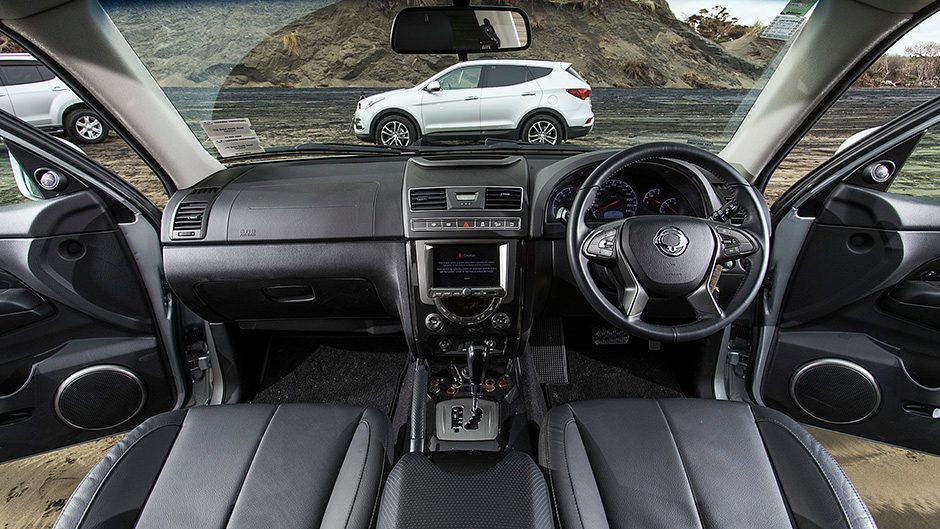
Meanwhile, the other two, switched to 4×4 on the go, just kept on trucking unperturbed. And as both have a low-range and far greater clearances, they’ll go much further off the beaten track. When it comes to towing, full chassis rigs are always able to tolerate bigger loads. As such, the Santa Fe is maxed out at 2000kg, which is 1000kg less than the Isuzu, while the Rexton is good for 3200kg. For town duties, each has lightweighted steering, but the big guys require a bit more turning on the wheel, especially the MU-X, and it has the biggest turning circle. They also feel more of the bumps on the go but countering this, they glide better over speed humps.
What’s on offer?
The Santa Fe has the most car-like interior and is heaving with gear but you’d hope so in a Hyundai costing $80k. It’s well made with premium feel materials and has a modern look to its layout. If you’re the type that thinks ‘what do I need all that stuff for?’ you won’t be wanting to spend up on the top spec Santa Fe. It’s got everything; heated and cooled seats, auto parking, powered tailgate, smart key and a range of active safety features. Adaptive cruise control is certainly handy if you’ve plenty of highway miles to travel, but this Hyundai system isn’t that great in city traffic compared with others we’ve tried while the blind spot system requires a big gap in the traffic before it will let you push across. You often have to ignore the beeps and just make the move. The autonomous braking function however is a good thing to have, just in case. You can buy the base model diesel Santa Fe if you don’t want all ‘the guff’ but even that retails for $66,990.
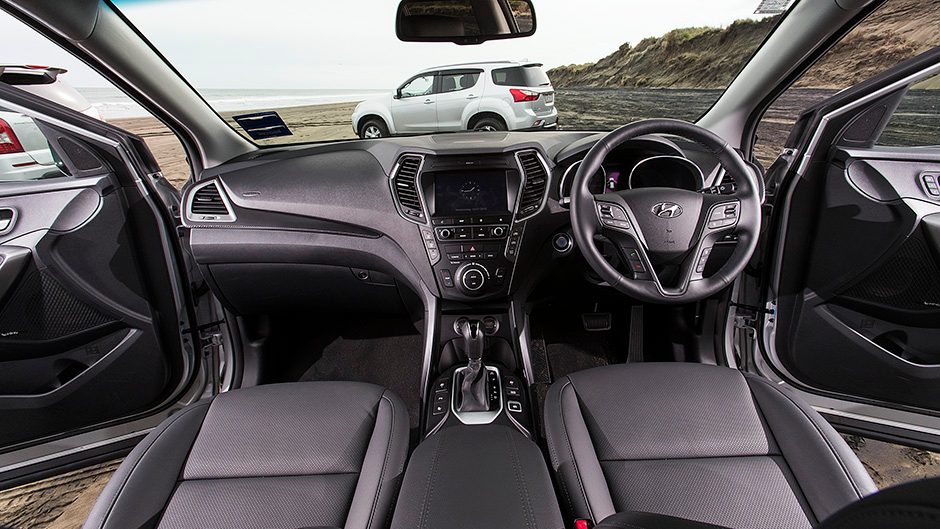
The SsangYong and Isuzu head down a more utilitarian path with their interiors, though still manage to include items like powered leather seats. There are no smart keys, powered fifth doors or active safety features, but that’s reflected in the price. The Rexton’s infotainment system lacks for few functions and it has an HDMI input for smartphone mirroring, delivering all the functionality of your phone to the touch screen system. The safety kit includes ESP but only a pair of airbags though, like the others here, it gets a reversing camera and rear sensors. The Rexton’s cabin is lined with a liberal amount of soft trim to lift its overall quality feel and it’s well constructed. Over in the Isuzu, its cabin has an abundance of hard plastic; it’s more like a ute inside in that regard and the finishing of the leather trim leaves a bit to be desired. The touch screen infotainment system has navigation, and a rear DVD system will keep the kids occupied. It has full size curtain air bags and good storage, and though the seats are powered, they don’t have a great range of adjustment.
Room for the family?
Each has good space inside for families on the go. The Hyundai is smaller than the full-size rigs, and therefore doesn’t have quite the same amount of space on offer. There’s not much in it for rear seat space between them all, and all have Isofix for child car seats. Hyundai has the best shaped boot thanks to its low load height; the others have high-set boot floors as they need to accommodate the solid axle and all of its articulation below. But then the Santa Fe has the least space for the sixth and seventh passengers; they are reserved for the kids alone with virtually no leg- and head-room for adults. The MU-X has both the most room and best access with a second row that folds and rolls with just one lever to pull. The Rexton is reasonably roomy too in the rearmost seat, save for a lack of foot space.
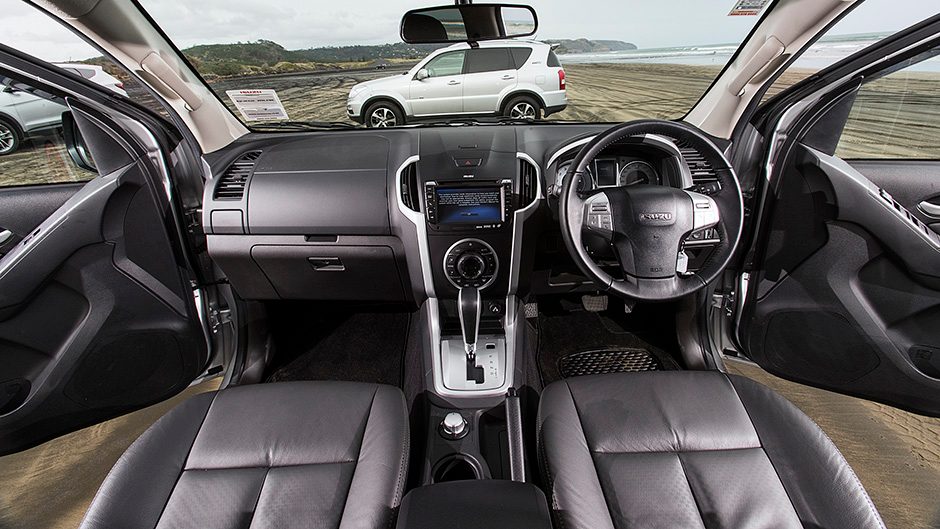
The Santa Fe is lower and sleeker than the others, looking like the softroader it is, while the others wear the rugged agrarian look. The Isuzu’s grille makes it seem like a predator on the hunt for things to eat. You see them running around the big smoke on 20-inch wheels. People are clearly more in it for the big SUV look than the actual off-road ability. The Rexton too looks better on bigger alloys, and has the usual SUV traits of flared guards and big proportions to emphasise the potential.
So where’s the real value?
The Isuzu powertrain is outclassed here, and looks expensive at $65k. The Hyundai is more refined and suited to city life, but is too expensive, even at its entry diesel pricing. It also lacks the all-round SUV versatility of the others. It’s hard to ignore the value proposition of the Rexton 2.2. It has a great powertrain, particularly its economy, and is capable in all the traditional SUV ways, with plenty of off-road ability, heaps of tow and yet it is civilised enough for town and school run duties, all for under $50k.
| Model | SsangYong Rexton Sport 2.2 | Price | $49,990 |
| Engine | 2157cc, IL4, TDI, 131kW/400Nm | Drivetrain | 7-speed auto, switchable 4×4 |
| Fuel Use | 7.4L/100km | C02 Output | 194g/km |
| 0-100km/h | 10.95sec | Weight | 1995kg |
| Model | Isuzu MU-X | Price | $65,990 |
| Engine | 2999cc, IL4, TDI, 130kW/380Nm | Drivetrain | 5-speed auto, switchable 4×4 |
| Fuel Use | 8.3L/100km | C02 Output | 223g/km |
| 0-100km/h | 11.49sec | Weight | 2141kg |
| Model | Hyundai Santa Fe 2.2 Elite Limited | Price | $82,990 |
| Engine | 2199cc, IL4, TDI, 147kW/440Nm | Drivetrain | 6-speed auto, on-demand AWD |
| Fuel Use | 7.7L/100km | C02 Output | 204g/km |
| 0-100km/h | 9.16sec | Weight | 1949kg |


